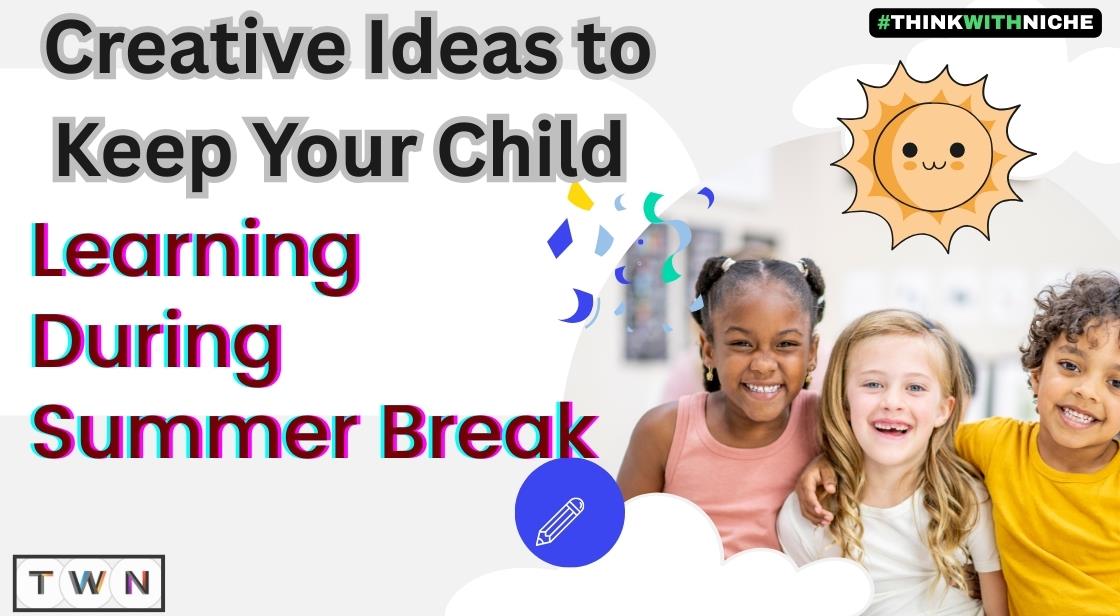Creative Ideas to Keep Your Child Learning During Summer Break

Blog Post
Summer vacation is often seen as a well-deserved break from the rigors of school—a time for kids to relax, play, and recharge. While downtime is essential for a child’s well-being, extended breaks without intellectual engagement can lead to what educators call the "summer slide," where children lose some of the academic progress they made during the school year.
Fortunately, summer doesn’t have to be a pause in learning. With thoughtful planning and creative ideas, parents can transform this time into a rich, stimulating experience that fosters growth, curiosity, and joy.
By blending proven educational theories with practical activities, summer can become an exciting season of discovery that prepares children not only for the next school year but for a lifelong love of learning.
In this article, we explore the science behind summer learning and offer creative, theory-based ideas to help parents make summer both educational and fun for their children.
How to Make Summer Vacation Educational and Enjoyable for Kids
Summer break is often viewed as a time for rest, relaxation, and fun. While it's essential for children to unwind and recharge, the long vacation can sometimes lead to a phenomenon known as the "summer slide"—a decline in academic skills and knowledge due to lack of practice. The good news? Learning doesn’t have to stop when school’s out. With a little creativity and planning, summer break can become a season of growth, exploration, and joyful learning.
Understanding the Theory Behind Summer Learning
The Summer Slide: What Research Says
Educational theorists and researchers have long acknowledged the concept of "summer learning loss." Studies by the National Summer Learning Association and researchers like Harris Cooper (Duke University) show that students typically lose about two months of grade-level equivalency in mathematical computation skills over the summer. Reading and writing skills also decline, particularly among lower-income students who may have less access to educational resources.
This leads to the Cumulative Learning Loss Theory, which explains that such setbacks accumulate over time, widening the achievement gap between students from different socio-economic backgrounds.
Constructivist Learning Theory
One of the most effective educational theories to guide summer learning activities is the Constructivist Learning Theory, developed by Jean Piaget and later expanded by Lev Vygotsky. According to this theory, children construct knowledge through active exploration, problem-solving, and social interaction. Summer provides the perfect setting for experiential learning, where children learn by doing—whether in nature, in museums, or during travel.
Also Read: Healthy Smoothies to Start Your Summer Mornings Right: Beat the Heat
Creative Summer Learning Ideas Based on Theory and Practice
1. Nature-Based Learning and Outdoor Exploration
Theory: According to Piaget’s theory of cognitive development, hands-on activities in natural settings foster critical thinking and curiosity.
Ideas:
-
Create a “backyard biodiversity journal” where your child records daily observations of birds, insects, and plants.
-
Organize family hikes or nature scavenger hunts to teach kids about ecosystems and geography.
-
Start a small garden. Gardening teaches biology, patience, and responsibility.
Why it works: It integrates science, writing, and art, promoting inquiry-based learning in a fun, low-pressure way.
2. DIY Science Experiments at Home
Theory: Experiential learning theory by David Kolb emphasizes learning through experience and reflection.
Ideas:
-
Conduct simple experiments like making a volcano with baking soda and vinegar.
-
Explore physics with paper airplanes—measure how far they fly and why.
-
Learn about states of matter by making homemade ice cream.
Why it works: These hands-on experiments strengthen problem-solving skills and scientific thinking.
3. Literacy-Rich Activities
Theory: Vygotsky’s Zone of Proximal Development (ZPD) stresses the importance of guided learning and social interaction in language development.
Ideas:
-
Create a summer reading challenge with a mix of fiction, non-fiction, and graphic novels.
-
Encourage journal writing—daily diaries, travel logs, or creative stories.
-
Set up a book club with friends or family.
Why it works: Reading and writing build vocabulary, comprehension, and critical thinking skills in a self-directed way.
4. Math in Daily Life
Theory: According to Situated Learning Theory by Jean Lave, learning is most effective when embedded in real-world activities.
Ideas:
-
Let kids help with grocery shopping—comparing prices, calculating discounts.
-
Bake together to explore measurement and fractions.
-
Play board games like Monopoly or Uno to practice arithmetic and logic.
Why it works: Children understand the relevance of math, making learning more meaningful.
5. Creative Arts and Expression
Theory: Multiple Intelligences Theory by Howard Gardner recognizes the value of different learning styles—musical, kinesthetic, visual-spatial, etc.
Ideas:
-
Offer supplies for drawing, painting, or crafting.
-
Encourage children to compose music or perform skits.
-
Use apps or websites for digital storytelling or animation.
Why it works: Artistic expression enhances emotional intelligence and problem-solving abilities.
6. Digital Learning Tools
Theory: Connectivism, developed by George Siemens, emphasizes learning through digital networks and information sharing.
Ideas:
-
Use educational platforms like Khan Academy, Duolingo, or Scratch for interactive learning.
-
Let kids code games or design websites.
-
Explore virtual museums or online courses on topics of interest.
Why it works: It integrates technology into learning and fosters digital literacy.
7. Project-Based Learning (PBL)
Theory: Rooted in John Dewey’s Progressive Education Theory, PBL emphasizes learning by doing through long-term inquiry and real-world relevance.
Ideas:
-
Help your child create a passion project, such as a mini-documentary or personal blog.
-
Organize a family research project—explore a country, an era in history, or a famous person.
-
Encourage entrepreneurial projects like lemonade stands or recycling drives.
Why it works: Projects boost independence, research skills, and creativity while nurturing curiosity.
8. Travel and Cultural Learning
Theory: Sociocultural Theory, also by Vygotsky, highlights the role of social environment and culture in learning.
Ideas:
-
Visit historical landmarks, museums, and cultural festivals.
-
Learn basic phrases from a foreign language before a trip.
-
Try cooking international dishes together.
Why it works: Travel expands worldviews and introduces children to diverse perspectives and traditions.
9. Life Skills and Responsibility
Theory: Montessori Philosophy promotes real-life tasks to build confidence, independence, and practical intelligence.
Ideas:
-
Teach children basic cooking, cleaning, budgeting, or first aid.
-
Let them take responsibility for daily chores or planning a family outing.
-
Practice goal setting and self-reflection.
Why it works: Life skills foster autonomy and readiness for real-world challenges.
10. Social Learning and Group Activities
Theory: Bandura’s Social Learning Theory stresses the importance of modeling and peer interaction in learning.
Ideas:
-
Enroll in summer camps, workshops, or community programs.
-
Encourage group sports, book clubs, or volunteering.
-
Set up collaborative projects with friends or siblings.
Why it works: Children learn from peers and develop teamwork, empathy, and communication skills.
Structuring a Balanced Summer Learning Plan
Creating a summer learning plan for your child doesn’t have to mean rigid schedules or overwhelming to-do lists. Instead, the key to success lies in balancing structure with flexibility, allowing your child to explore their interests while maintaining consistent engagement. A well-balanced plan promotes creativity, independence, and joy in learning.
Mix Structured and Unstructured Time
One of the most effective approaches is to blend structured learning sessions with ample unstructured free time. Structured time might include specific activities like reading, science experiments, or math games—planned enough to provide focus but flexible enough to adapt to your child’s mood and energy levels. Unstructured time is equally important; it allows your child to engage in imaginative play, outdoor adventures, or simply rest. This balance prevents burnout and encourages intrinsic motivation, as children feel free to discover learning at their own pace.
Set Weekly Goals and Themes
Setting weekly goals or themes can provide a gentle framework to guide your child’s summer learning. For example, designate one week as “Nature Exploration Week” with activities like hiking, bird watching, or gardening, and another as “Art and Creativity Week” with painting, crafts, or storytelling. Involving your child in choosing these themes empowers them and fosters ownership over their learning journey. These thematic blocks also keep learning fresh and exciting by introducing variety and new challenges regularly.
Celebrate Achievements
Recognizing and celebrating your child’s efforts is crucial to maintaining motivation throughout the summer. Positive reinforcement can take many forms—verbal praise, stickers, certificates, or a special treat for completing a project or reaching a goal. Celebrations don’t have to be grand; even small acknowledgments can boost your child’s confidence and reinforce the joy of learning. Celebrating milestones also helps children reflect on their progress and set new targets.
Be a Role Model for Lifelong Learning
Children learn best by example. When parents show enthusiasm for learning—whether by reading books, trying out new hobbies, or exploring the world around them—children are naturally inspired to do the same. Share your curiosity openly, involve your child in your own learning experiences, and approach challenges with a positive attitude. This modeling helps instill a growth mindset, teaching kids that learning is an exciting, lifelong process rather than just a school task.
Conclusion
Summer break is not just a pause in formal education—it’s an opportunity to embrace learning in its most joyful and creative form. By tapping into educational theories and implementing hands-on, engaging activities, parents can help children stay mentally active, emotionally balanced, and ready for the school year ahead.
Whether it’s building a treehouse, solving math puzzles, creating a family newspaper, or stargazing on a clear night, every moment can be a stepping stone to discovery. With a little inspiration and thoughtful planning, summer can be the most educational season of all—without ever feeling like school.
You May Like
EDITOR’S CHOICE












